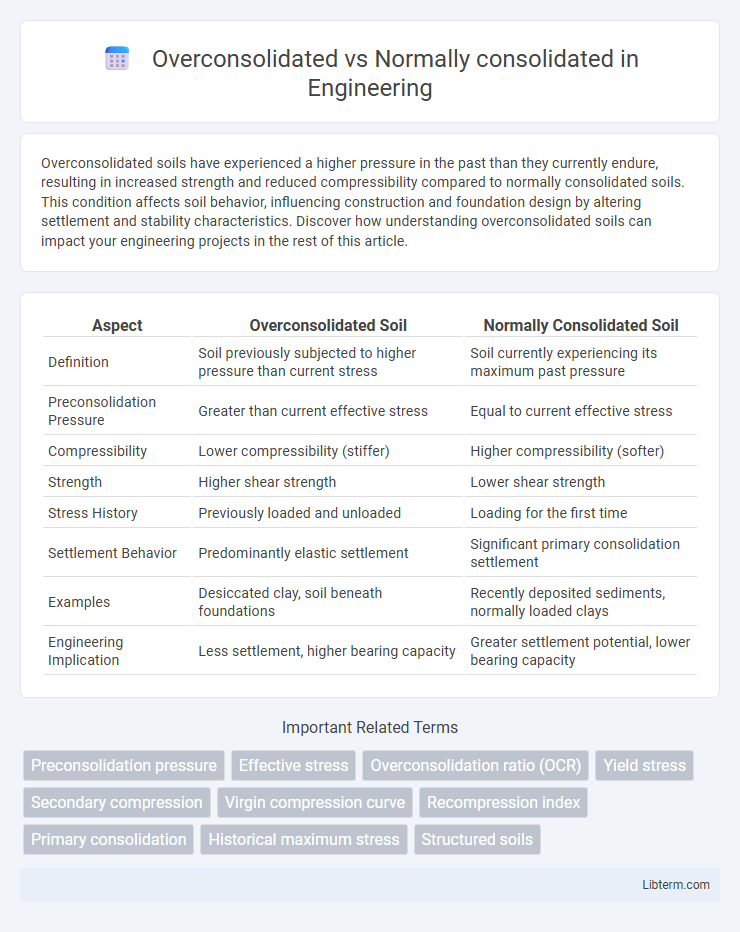Overconsolidated soils have experienced a higher pressure in the past than they currently endure, resulting in increased strength and reduced compressibility compared to normally consolidated soils. This condition affects soil behavior, influencing construction and foundation design by altering settlement and stability characteristics. Discover how understanding overconsolidated soils can impact your engineering projects in the rest of this article.
Table of Comparison
| Aspect | Overconsolidated Soil | Normally Consolidated Soil |
|---|---|---|
| Definition | Soil previously subjected to higher pressure than current stress | Soil currently experiencing its maximum past pressure |
| Preconsolidation Pressure | Greater than current effective stress | Equal to current effective stress |
| Compressibility | Lower compressibility (stiffer) | Higher compressibility (softer) |
| Strength | Higher shear strength | Lower shear strength |
| Stress History | Previously loaded and unloaded | Loading for the first time |
| Settlement Behavior | Predominantly elastic settlement | Significant primary consolidation settlement |
| Examples | Desiccated clay, soil beneath foundations | Recently deposited sediments, normally loaded clays |
| Engineering Implication | Less settlement, higher bearing capacity | Greater settlement potential, lower bearing capacity |
Introduction to Soil Consolidation
Overconsolidated soils have previously experienced pressures greater than their current effective stress, resulting in dense particle arrangements and lower compressibility. Normally consolidated soils are subjected to their maximum historical effective stress for the first time, displaying higher compressibility and typical settlement behavior under load. Soil consolidation describes the gradual expulsion of water from saturated soils under sustained load, influencing settlement and strength characteristics critical for geotechnical engineering.
Defining Overconsolidated and Normally Consolidated Soils
Overconsolidated soils have previously experienced pressures greater than their current effective stress, resulting in a denser structure and reduced compressibility. Normally consolidated soils are those where the current effective stress matches the highest past pressure, indicating a virgin or first-time consolidation state. The degree of consolidation directly influences soil behavior, affecting parameters like shear strength and settlement characteristics.
Formation Processes of Consolidated Soils
Overconsolidated soils form when previously deposited soils undergo significant loading and subsequent unloading, often due to erosion or glacial retreat, resulting in a higher preconsolidation pressure than the current effective stress. Normally consolidated soils develop under continuous loading without any prior overburden removal, maintaining an effective stress equal to the maximum past stress experienced. The formation processes influence soil structure, permeability, and mechanical behavior, critical for geotechnical assessments and foundation design.
Geotechnical Properties Comparison
Overconsolidated soils exhibit higher shear strength and lower compressibility compared to normally consolidated soils due to their preloading history, which results in a denser particle arrangement and greater structural stiffness. Normally consolidated soils typically have higher compression indices and undergo larger primary consolidation settlements under applied loads, reflecting their virgin stress state. The permeability of overconsolidated soils is generally lower, and their preconsolidation pressure surpasses the current effective stress, influencing settlement behavior and stability analyses in geotechnical engineering.
Stress History and Preconsolidation Pressure
Overconsolidated soils have experienced a maximum past effective stress, known as preconsolidation pressure, greater than the current effective stress, reflecting a significant stress history with unloading and reloading cycles. Normally consolidated soils have a stress history where the current effective stress matches the maximum past stress, indicating no previous overburden removal and no preconsolidation pressure. Understanding the stress history and preconsolidation pressure is crucial for predicting soil settlement and strength characteristics in geotechnical engineering.
Identification Methods for Soil Consolidation State
Identifying overconsolidated and normally consolidated soils relies heavily on the analysis of consolidation test results, particularly the calculation of the preconsolidation pressure (s'p) from a one-dimensional consolidation test. An overconsolidated soil exhibits a preconsolidation pressure greater than the current effective stress, indicating past loading events, whereas normally consolidated soil shows s'p approximately equal to the current effective stress. Field methods such as vane shear tests and piezocone penetration tests (CPTu) combined with empirical correlations also assist in determining the soil consolidation state by evaluating strength parameters and pore pressure responses.
Settlement Characteristics and Behavior
Overconsolidated soils exhibit lower settlement under loading due to their preloaded history, resulting in higher stiffness and less compressibility compared to normally consolidated soils. Normally consolidated soils tend to experience larger primary consolidation settlements as they are loaded for the first time beyond their maximum past effective stress. The secondary compression in overconsolidated soils is typically less pronounced, while normally consolidated soils show more significant time-dependent settlement after primary consolidation.
Engineering Implications and Design Considerations
Overconsolidated soils exhibit higher shear strength and stiffness compared to normally consolidated soils, affecting foundation settlement and slope stability assessments. Engineering designs must account for lower compressibility and potential for soil rebound in overconsolidated clays, influencing excavation support and retaining wall design. Normally consolidated soils require careful evaluation of consolidation settlement and pore pressure dissipation to prevent excessive deformation and structural failure.
Common Applications in Construction and Geotechnical Engineering
Overconsolidated soils, typically found beneath urban areas or glaciated regions, provide higher shear strength and lower compressibility, making them suitable for supporting shallow foundations and embankments. Normally consolidated soils, commonly encountered in undisturbed natural deposits or recently deposited sediments, exhibit higher settlement potential and require careful consolidation analysis for deep foundation and slope stability design. Both soil types are critical in geotechnical engineering for selecting foundation systems, predicting settlement behavior, and designing earth-retaining structures in varied construction environments.
Summary of Key Differences and Practical Insights
Overconsolidated soils have previously experienced effective stress exceeding current levels, resulting in higher stiffness and lower compressibility compared to normally consolidated soils, which are currently at their maximum historical effective stress. Overconsolidation ratio (OCR) quantifies this difference, with OCR > 1 indicating overconsolidation and OCR 1 for normally consolidated soils. Practically, overconsolidated soils demand special consideration for shear strength and settlement predictions due to their altered stress history, while normally consolidated soils typically predict greater settlement under new loads.
Overconsolidated Infographic

 libterm.com
libterm.com